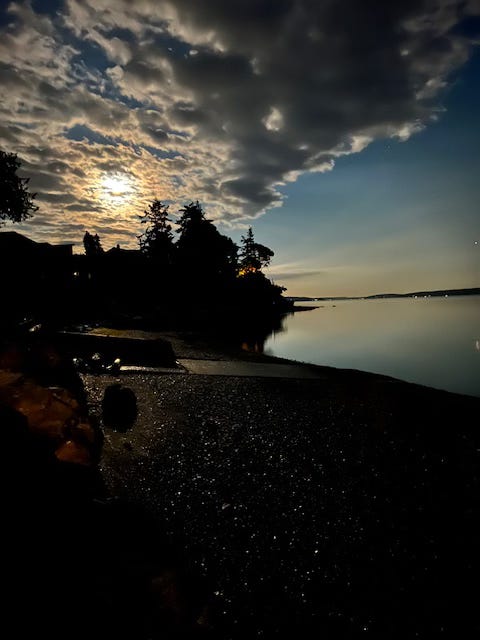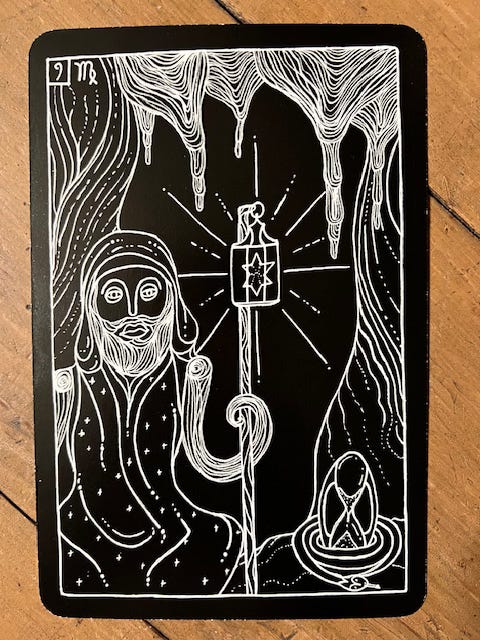The cold, clear February nights leading up to today’s new moon have been reminding me of night skies that held me in wonder a few years ago: CocooNele Artist’s Retreat, late summer, 2022.
Nebunele Theatre was a group of four extraordinary artist/activists who among other things were committed to unraveling destructive systems and structures both creative and political through intentional focus on process. I had engaged in feedback sessions with them for my 13 Cakes project and joined their number briefly before they disbanded but in 2022, they awarded/gifted me a two week sabbatical on Camano Island to fill how I wished. This was rich, revelatory time that still gifts me insight years later. It was the time to cocoon that so many of us rarely get or fully take advantage of when we do. I wrote, read, daydreamed, walked, larked and marveled. The time I spent on Camano fell within a lunar cycle and the dark brilliance of the new moon sky of my arrival stunned me into silence.
The dark reach of its unfathomable expansion gave the Camano night sky sway over my dreams and my writing time. The former were vivid and, cupped in the soft cold hand of black sky, feral with shimmering archetype. The latter was spent casting out for language that would come close to describing the inky magic that held my gaze. Like trying to take a cell phone shot of the moon, my efforts were doggedly inadequate. The writing was, at least though, informed by a lived understanding of darkness as full, inherently beautiful and essential. Thelonius Monk taught me this. Time spent in soil taught me this. Griefwork teaches me this.
I’ll return to the subject of language momentarily, but first, I’d like to share a dream with you. It’s one I had about a year ago, loud and vivid like those I had in my Camano cocoon. The kind that refuses to dissolve on awakening and imprints itself on your psyche. In the dream, I was moving with fearful and scattered urgency through the rooms of my house–which of course bore features of houses in which I had grown up. I was overwhelmed and anxious–there were too many things to do and so much seemed to rest on whether or not I got those things done. I could sense people-creatures lurking outside the house, hiding in bushes. Inching closer and trying to find a way in. I nervously eyed a partially open window in an adjoining room, an unseen breeze worrying its white curtains.
A man stood motionless in the dark on the back patio. He stared up at a brilliant night sky. I glared at his silhouette, angry that he wasn’t helping me get things done. He couldn’t even be bothered to shut the window! When I went out to confront the man, he placed his hand on my forearm and wordlessly pointed at the sky. It was a Van Gogh as only my deepest imagination could conjure it. It was numinous. Somehow, I resisted opening to the time slowing effects of the sky and tore myself away to reignite the fretting and castigation. Again, the faceless man patiently placed his hand on my forearm and pointed starward. Exasperated, I looked up at the dark beauty of stars, moon and black night. Time slowed.
I woke up just as dream Monica surrendered to the sense of possibility the stars were twinkling in their celestial morse code. What wonders the darkness holds! I woke understanding that in pointing at the stars, my animustic companion was trying to show me an essential and unchanging aspect of my Self.
In her essay An Urban Farmer’s Almanac: A Twenty-First-Century Reflection on Benjamin Banneker’s Almanacs and Other Astronomical Phenomena, Erin Sharkey’s own contribution to A Darker Wilderness: Black Nature Writing from Soil to Stars, the luminous collection she edited, she writes that “astrology has traditionally been a combination of long observation of the sky and its movements as related to the behavior of people and plants and other beings. Pattern marking or noticing, looking into the blackness and drawing visible lines between its points of light, taking shapes out of the stars.”
As above, so below. Carl Sagan said we are each made of starstuff. And who’s to say we are not also gazing up at ancestors and future helpers, all shining across time to remind us that we must do so for one another. We each are points of light and we each walk dark paths towards one another’s lanterns. What constellation looks like now for us on the ground is social proofing, connection. Congregate. Find your people. Be someone else’s person. Draw lines between us.
We seem to be talking lately as though we have (already) forgotten all the magic and safety and insight the dark can hold for us. A colleague describes an administration’s intentions as dark. A headline warns that Dark Times Are Coming for the labor movement. Another posits that the dark days are already here. Institutions and organizations have gone completely or partially dark, like for example, the Famine Early Warning Systems Network, or FEWS Net, a system that analyzes data to predict locations of extreme food insecurity so that aid can be directed proactively. The lives of huge numbers of individuals have been ‘cast into darkness’ as the result of mass layoffs across locations of public service near (to our hearts) and far.
We all–whoever we are: colleagues, parents, trans, non-binary or intesex people, immigrants, lovers of nature and public safety and spaces, journalists and storytellers– are searching for language, just as I was on Camano. Now though, we’re casting for language that will keep up with the pace and scope of the assaultive changes we are witnessing. Language that will convey the epochal shifts in which we are all participating, actively or otherwise. Language that will bear the weight of witnessing. And we are reaching for the metaphor of darkness, putting it to use in ways as predictable as the second act of fantasy novels. The dark is being used to convey all things destructive, untrustworthy, troubling, empty and uncertain. These uses belie a lack of imagination, an inability or refusal to see more of what is, and a general doomerism* that serves no one.
Yes, there are more shocking headlines than can be linked to. We’re all getting pelted in the face with them and I do want to hold this space for essays that feel more like spells than broadsides. So let’s finally agree that this shitstorm—promised, predicted, and itself part of a long unfolding—has indeed commenced in all its fascist glory, and let’s consider that the ways we are putting the idea of darkness to work solely in service of its negative charge suggests we are forgetting under pressure that how we use language and the stories we tell ourselves are directly linked to how we understand our own capacity to act and imagine.
For those who need reminding of the fullness, potential and necessity of darkness, Lyanda Lynne Haupt’s chapter on darkness in Rooted: Life at the Crossroads of Science, Nature, and Spirit is a fine place to start:
“Darkness possesses its own essential grace. It is darkness that bears liminal imaginings more difficult to access in the scattered daylight. Darkness brings the restorative sleep and dreaming our bodies and psyches require. Darkness takes the harried busyness of the day and transforms it to stillness, to quiet. Darkness brings us starlight. Darkness erases our view of the horizon, forcing our reliance upon a spacious inner vision that daylight cannot provide. Darkness offers a complex refuge for all beings and all aspects of being.”
It’s so hard to know what’s on the horizon. I’ve heard more than one person say it is impossible to imagine 2026. Expanding our sense of what’s possible within and with the dark is a place to start. What spacious inner visions might the dark help to midwife?
“Ninety percent of life,” Haupt adds later, “unfolds in complete and eternal darkness–beneath the soil that cradles every footstep, and beneath the sea, where whole worlds exist absent the penetration of any light at all”. And yet, “somehow, in our language and in our psyches, we have come to equate good with light and evil with darkness.” While the metaphor is pervasive, its dualism is limiting, unhelpful and frankly boring. We can embrace the promise of renewal the rising sun offers “without banishing darkness as antithetical to the good in our modern cultural mythology.” It is only helpful to think of ourselves as in the dark if we can recognize and act on what that might mean and make possible. Holding both/and is a capacity.
I was too awestruck when I first arrived on Camano to think to take a picture of the new moon sky. But, while staring skyward my last night there I realized I’d want a visual aid to remind me of that black expanse. The image I managed on my cell was predictably inadequate but it captured for me twin darknesses of sky and earth. The reflected light of the full moon off the shell-littered beach mimicked the stars that are always there, shining and collectively beyond the grasp of the lunar or news cycles that might try to obscure them.
How might we hold spaces of “complex refuge” for one another? How has the dark supported your life and how does it hold you? How will we find each other’s lanterns on the dark path? What can we dream together that we can’t dream alone?
xx
*Thanks Hamilton Nolan, for the new word.






Beautiful reflection; I’m reading “Night Magic” right now and savoring every word so far 🌟
I definitely would not exist if the dark had not held me and shown me who I always was time and time again. Thank you for writing about this!